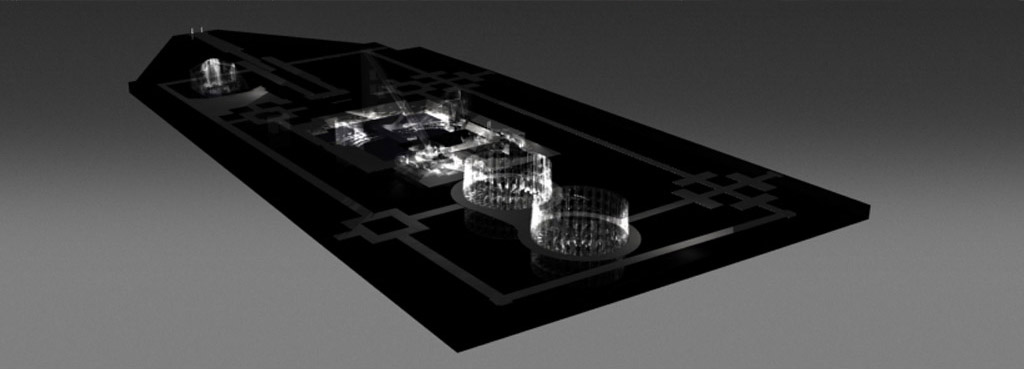The Garden of Instruments
-
Paul Schütze
This project began in 1997 with the composition of Second Site - a 102 minute sound work for percussion, voice and electronics. The piece is part of an ongoing series of projects concerned with the experience of architectural space and its relationship to the mind, memory, consciousness and our mapping of the world.
The subject is the Jantar Mantar observatory gardens in Delhi built in the seventeen hundreds by Mogul Emperor Jai Singh II.
As with other projects in this series (Third Site for example), it has expanded over time to include additional elements in a variety of media. With these developments I hope to further articulate the complex nature of our experience of both occupying and conceiving built structures, and look further at the various "languages" revealed by the senses when we move through the time and place of building.
When I approached Kevin Pollard to model the Jantar Mantar from what documentation we could locate (drawings, photographs written descriptions), I had some idea of a poetic reduction of the real structure. Removing the now chaotic urban setting of downtown Delhi from view and rendering the various structures as transparent seems to bring the model closer to the spirit of the original observatory and to encapsulate its purpose (the measurement of light) within the images made.
I have been keen throughout the animation and filming of the model itself to limit movement either of the viewer or the model to formal tracking shots resisting all the characteristic swoops and accelerated arcs so ubiquitous in CGI.
We also chose to limit the tonal range of the model despite the infinite possibilities offered by the software. My thinking here was to undermine the familiar cues of CAD rendering and allude to a "cinematic" grammar and association.
The slow dissolving monochrome tracks of the first film take their pace and character from the music to which David Thorpe and I edited the animated sequences.
This film runs for the entire 102 minutes of the original sound work. The second film, which is considerably shorter, has been made by re-filming sections of the longer film as it moves across a transparent, reflective armature which is itself moving slowly.
The two films are intended to be screened facing one another so only one can be seen at a time.
The second film has a random association with the sound owing to its different duration and lack of synchronization.
Two suites of lightboxes have been made which also proceed from the original CAD model. These are "still photographs" of the model made by choosing a viewing point and then lighting the shot and rendering this view.
Technically this is an interesting process as the choice of view and lighting is made in a tiny wireframe window and is to a huge degree speculative. The render time on such large images (one suite is A0 the other A1) is considerable so the trial and error approach can be very time consuming.
The lightboxes are able to show far greater detail and complexity of light than either of the animations owing to the computing time required to make 25 "views" every second in the case of the film.
Each aspect of the project thus concentrates on a different aspect of the whole structure and experience. I am currently working on a series of lenticular prints which derive from frame grabs of the second film.
Each lenticular holds twelve images which crossfade one to the next as the viewing angle (horizontal) is changed.

Several generations removed from the CAD model this object frays and moulds elements of the architecture into slivers of light which both comprise and obscure the original structures.
© paul schutze : january 2006